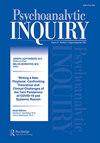Mapping Obscura: Locating the Space and Non-Space of Memory and Home through the Photograph
IF 0.5
4区 心理学
Q3 PSYCHOLOGY, PSYCHOANALYSIS
引用次数: 0
Abstract
ABSTRACTWhat does it mean to inhabit? Our many selves find dimensionality through time and in place. This is complicated through the event of mass migration and trauma. One is continuously mapped through a locating of interiority. Within this essay, Nayar traces the birth and evolution of place as interior, and the genesis of her hybrid, constructed photographic process. Through the lens of India’s 1947 Partition, a trajectory of trauma and the ways in which memory functions over time is traced and translated through a family’s resettlement home in New Delhi. Built by her maternal grandfather, a refugee and psychiatrist from East Bengal, this locus in Nayar’s memory sheds light on how one may understand the many intersections of belonging and place. Home is found in habitation, that of desire and the awakening of the Mother. In this way, attachment theory, Winnicott’s transitional object, and the uncanny are touchstones for an internal mapping of psychic space. Through this framework, one understands what it means to embody through time and what is, through the process, left behind.KEYWORDS: Mappingspacememoryhomephotographytransitional objectmothermigrationcamera obscurainhabitlandscapearchitectureNew DelhitimePartitionIndia Disclosure statementNo potential conflict of interest was reported by the author.Notes1 Roland Barthes, Camera Lucida: Reflections on Photography (Hill and Wang, 2010), pp. 39–40.2 The Partition of India refers to a historical event in 1947 when the British colony formally dissolved and resulted in the creation of two independent dominions, India and Pakistan. Created along religious Hindi-Muslim lines, the event resulted in large-scale violence, mass deaths and a refugee crisis.3 Photo paper is different from plain paper in that it has a cast coating layer that can receive and imprint an image.4 Camera Lucida, p. 40.5 East Bengal, with its majority Muslim population, became part of the Pakistani state and its name was changed to East Pakistan as a result of Partition. In 1971, after a series of uprisings by Bengali nationalists, East Pakistan became an independent country, Bangladesh, which it is still today.Additional informationNotes on contributorsYamini NayarYamini Nayar lives and works in Brooklyn, New York. She is currently an analyst-in-training at the C.G. Jung Institute, New York. Nayar’s work is represented by Jhaveri Contemporary, Mumbai, Gallery Wendi Norris, San Francisco and Thomas Erben, New York.Nayar has shown her work internationally at venues including the Museum of Moderne Kunst Frankfurt, Freud Museum London, Rencontres d’Arles, Yerba Buena Center for the Arts, Queensland Art Gallery in Australia, DeCordova Museum MA, Kiran Nadar Museum New Delhi, Sharjah Biennial in UAE, Saatchi Gallery UK, and Serendipity Arts Festival, Goa, India. Public collections include Solomon Guggenheim Museum NY, Kiran Nadar Museum, Saatchi Museum, Queensland Art Gallery, Cincinnati Art Museum, Hiscox and US Arts in Embassies, JP Morgan Chase. Publications include: 20th Century Indian Art, Modern, Post-Independence, Contemporary, editors Partha Mitter, Parul Dave Mukherji, Rakhee Balaram (Thames and Hudson, 2022); Global Photography: A Critical History, editors Heather Diack, Erina Duganne, Terri Weissman (Routledge, 2020); Chandigarh is in India, edited by Shanay Jhaveri (Shoestring Publishers, 2016); Passages: Indian Art Today (Daab Media, 2014); Lines of Control, Partition as a Productive Space (Green Cardamom, 2012); Unfixed: Postcolonial Photography in Contemporary Art (Jap Sam Books, 2013); Empire Strikes Back: Contemporary Indian Art Today (Saatchi) and Manual for Treason: Sharjah Biennial, edited by Murtaza Vali (2011). Nayar’s work has been featured in The New York Times, New Yorker, Art India, Artforum, Art in America, Frieze, Art Papers, and others. Residencies and grants include Lower Manhattan Cultural Council Workspace, Center for Photography at Woodstock, Art Academy of Cincinnati and NYU Visiting Artist Scholar. Nayar has received the Lightborne Fellowship, Aaron Siskind Scholarship, an Art Matters Foundation grant. Nayar holds an MFA from the School of Visual Arts, New York, and BFA from Rhode Island School of Design.Nayar’s work intersects photography, sculpture and varied forms of architecture to interrogate our relationship to the built world and thus, ourselves. In her studio-based practice, the photograph is the remaining object of an invested process of making, building, deconstructing and forming new roads to the built environment. In this way, how we remember is central, hand in hand with how we make meaning.测绘暗箱:通过照片定位记忆与家的空间与非空间
栖息是什么意思?我们的许多自我通过时间和地点找到维度。由于大规模移民和创伤事件,这一问题变得更加复杂。一个是通过内部定位连续映射的。在这篇文章中,Nayar追溯了作为内部的地方的诞生和演变,以及她混合的、建构的摄影过程的起源。通过1947年印度分治的镜头,通过一个家庭在新德里的重新安置,追溯了创伤的轨迹和记忆随着时间的流逝而发挥作用的方式。纳亚尔的外祖父是一名来自东孟加拉的难民和精神病学家,她的外祖父建造了这座建筑,这座位于纳亚尔记忆中的建筑向我们展示了一个人如何理解归属感和地方的许多交叉点。家是在居住中找到的,那是欲望和母亲的觉醒。通过这种方式,依恋理论、温尼科特的过渡对象和神秘是心理空间内部映射的试金石。通过这个框架,人们理解了通过时间的体现意味着什么,以及通过这个过程,留下了什么。关键词:测绘、空间、记忆、家庭摄影、过渡对象、母亲、迁徙、相机、隐蔽、习惯、景观建筑、新德里、分区、印度注1 Roland Barthes, Camera Lucida: Reflections on Photography (Hill and Wang, 2010), pp. 39-40.2印度的分裂是指1947年的一个历史事件,当时英国殖民地正式解散,导致印度和巴基斯坦两个独立的领土的创建。这一事件是根据印度教和穆斯林的宗教界线而产生的,导致了大规模的暴力、大规模的死亡和难民危机相纸与普通纸的不同之处在于它有一层可以接收和印印图像的铸造涂层以穆斯林人口为主的东孟加拉成为巴基斯坦的一部分,由于分治,它的名字改为东巴基斯坦。1971年,在孟加拉民族主义者的一系列起义之后,东巴基斯坦成为一个独立的国家,孟加拉国,直到今天。亚米尼·纳亚尔亚米尼·纳亚尔在纽约布鲁克林生活和工作。她目前是纽约荣格研究所(C.G. Jung Institute)的培训分析师。纳亚尔的作品在孟买Jhaveri Contemporary、旧金山Wendi Norris画廊和纽约Thomas Erben画廊展出。纳亚尔的作品曾在法兰克福现代艺术博物馆、伦敦弗洛伊德博物馆、阿尔勒当代艺术博览会、芳草艺术中心、澳大利亚昆士兰美术馆、马萨诸塞州DeCordova博物馆、新德里Kiran Nadar博物馆、阿联酋沙迦双年展、英国萨奇画廊和印度果阿的Serendipity艺术节等国际展览场所展出。公共藏品包括纽约所罗门古根海姆博物馆、基兰纳达尔博物馆、萨奇博物馆、昆士兰美术馆、辛辛那提艺术博物馆、希斯科克斯和美国大使馆艺术、摩根大通。出版物包括:20世纪印度艺术,现代,后独立,当代,编辑Partha Mitter, Parul Dave Mukherji, Rakhee Balaram (Thames and Hudson, 2022);《全球摄影:一段批判的历史》,编辑Heather Diack、Erina Duganne、Terri Weissman (Routledge出版社,2020年);《昌迪加尔在印度》,沙内·贾维尼编辑(Shoestring出版社,2016年);《段落:今日印度艺术》(Daab Media, 2014);控制线,作为生产空间的分区(绿色豆蔻,2012);不固定:当代艺术中的后殖民摄影(日本山姆图书,2013);《帝国反击战:当代印度艺术》(萨奇)和《叛逆手册:沙迦双年展》,穆尔塔扎·瓦利编辑(2011)。纳亚尔的作品曾被《纽约时报》、《纽约客》、《印度艺术》、《艺术论坛》、《美国艺术》、《弗里兹美术展》、《艺术论文》等媒体报道。驻留和资助项目包括曼哈顿下城文化委员会工作空间、伍德斯托克摄影中心、辛辛那提艺术学院和纽约大学访问艺术家学者。Nayar曾获得Lightborne Fellowship, Aaron Siskind奖学金和艺术事务基金会的资助。纳亚尔拥有纽约视觉艺术学院的艺术硕士学位和罗德岛设计学院的艺术学士学位。Nayar的作品与摄影,雕塑和各种形式的建筑相交叉,询问我们与建筑世界的关系,从而询问我们自己。在她以工作室为基础的实践中,照片是制作、建造、解构和形成通往建筑环境的新道路的投资过程的剩余对象。通过这种方式,我们如何记忆是核心,与我们如何创造意义密切相关。
本文章由计算机程序翻译,如有差异,请以英文原文为准。
求助全文
约1分钟内获得全文
求助全文
来源期刊

Psychoanalytic Inquiry
PSYCHOLOGY, PSYCHOANALYSIS-
CiteScore
1.00
自引率
33.30%
发文量
65
期刊介绍:
Now published five times a year, Psychoanalytic Inquiry (PI) retains distinction in the world of clinical publishing as a genuinely monographic journal. By dedicating each issue to a single topic, PI achieves a depth of coverage unique to the journal format; by virtue of the topical focus of each issue, it functions as a monograph series covering the most timely issues - theoretical, clinical, developmental , and institutional - before the field. Recent issues, focusing on Unconscious Communication, OCD, Movement and and Body Experience in Exploratory Therapy, Objct Relations, and Motivation, have found an appreciative readership among analysts, psychiatrists, clinical psychologists and a broad range of scholars in the humanities.
 求助内容:
求助内容: 应助结果提醒方式:
应助结果提醒方式:


